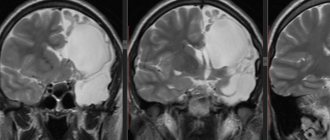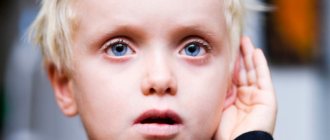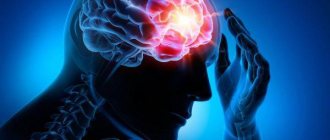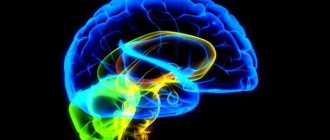Reasons for formation
The development of the cycloid type is influenced by certain factors, in particular genetic predisposition, as well as characteristics of parental upbringing. A cyclothymic may begin to demonstrate its character from childhood, which will become very noticeable in adolescence. In such a young man, a depressive state is easily replaced by euphoria, and this, in turn, is replaced by depression. There are risk factors that can provoke the development of psychopathy:
- neurological or psychological pathologies diagnosed in relatives,
- infectious diseases accompanied by high temperature and severe intoxication,
- head injuries,
- use of toxic substances,
- psychological trauma.
Cycloid type
Accentuations of character and parenting style Read more: Hysterical type
2. Cycloid type.
Adolescents of the cycloid type experience lethargy, loss of strength, apathy and irritability. They begin to feel burdened by communication with other people. Cycloid teenagers have a hard time experiencing minor troubles and failures. This type of accentuation is characterized by drowsiness and decreased appetite. Such teenagers may respond with irritation and anger to reproaches and remarks, although deep down they become even more despondent.
The behavior of cycloids is distinctive: during the period of recovery, adolescents look like hyperthymes, their unusual desire to make jokes and jokes is striking; during a recession, they are easily irritated and quarrel with others over trifles.
For teenagers of the cycloid type, the past is more attractive than the future, so they strive for stability, stereotyping, established habits, tastes, and rituals.
With emotional rejection, parents do not show sincere love and affection towards the teenager and do not provide support. The child feels the artificiality of a caring attitude towards himself, a certain duality, which can explain the manifestation of instability of behavior with others.
3. Labile type
The main feature of adolescents of the labile type is extreme lability of mood, which changes too often and excessively sharply for reasons unnoticeable to others. Well-being, appetite, performance, and sociability depend on the mood of a given moment. Unmotivated mood swings create the impression of frivolity and superficiality among others. In fact, labile teenagers are distinguished by their depth of feelings and great and sincere affection. They prefer to be friends with those who are able to react to the emotions that arise (both positive and negative).
Labile teenagers love companies and new surroundings, finding new experiences in them. Sensitivity to signs of attention, praise, and gratitude is not combined with arrogance or self-conceit.
An unfavorable situation for this type is emotional rejection from significant others, or separation from them. Therefore, it is necessary to establish emotional contact with the teenager, provide spiritual support and an optimistic attitude.
4. Asthenoneurotic type.
Increased fatigue, irritability and a tendency to hypochondria are the main features of the asthenoneurotic type of character accentuation. Fatigue is especially evident during mental activities and emotional stress. Irritability leads to sudden affective outbursts, sometimes arising for insignificant reasons. The tendency to hypochondriasis is expressed in the teenager’s listening to his bodily sensations, susceptibility to examinations and examinations.
Asthenoneurotic teenagers are drawn to their peers, but quickly get tired of their company, preferring loneliness or communication with one close friend.
Representatives of this type prefer not to look into the future, because This increases already high anxiety. But the present does not satisfy them either.
The form of psychological defense of an asthenoneurotic teenager is irritability and “withdrawal into illness.” For this type of character accentuation, dominant hypoprotection is unacceptable, when a teenager is forced to constantly be under supervision. It is important for a teenager to organize a normal, healthy lifestyle by alternating mental and physical activity.
5. Sensitive type.
In adolescence, two main features of the sensitive type are identified: excessive impressionability and a periodically arising feeling of one’s own inferiority. This type is characterized by an early developing sense of duty and responsibility, excessive demands on oneself and others. Teenagers see many shortcomings in themselves, especially in the area of moral, ethical and volitional qualities.
Childhood attachment to relatives remains. Representatives of the sensitive type show willing submission to the care of elders. Overcompensation is pronounced. Teenagers seek self-esteem not in areas where their abilities can be revealed, but in areas where they feel weak.
They do not have hopes for the future, the present does not satisfy them, and in the past they see only negative reviews addressed to them (true or imaginary), insults, ridicule, and humiliation.
Sensitive teenagers perceive the world around them anxiously, so work should be aimed at strengthening a sense of self-confidence, since the source of disharmony is deep internal dissatisfaction with oneself, which cannot happen if the teenager is emotionally rejected by his parents.
6.Psychoasthenic type.
Representatives of the psychoasthenic type are characterized by indecision, a tendency to endless reasoning, anxious suspiciousness and a love of introspection; as well as the ease of occurrence of obsessive concerns, actions, fears, thoughts, ideas. Invented signs and rituals, pedantry and formalism become psychological protection against constant worries about the future.
Indecision in action is especially visible in hesitation, when it is necessary to make an independent choice, and the decision already made must be immediately executed. Psychoasthenic adolescents experience a reaction of overcompensation in relation to their indecision and uncertainty, which manifests itself in unexpected self-confident judgments and hasty actions.
The places of least resistance for such adolescents are situations that place increased demands on a sense of responsibility. When a child is left to his own devices, he is forced to make independent choices and make responsible decisions with a hypoprotective parenting style.
7. Schizoid type.
In adolescence, one is struck by isolation, isolation from the environment, reluctance to establish contacts, inability to empathize; the inner world is often filled with fantasies and hobbies among representatives of the schizoid type. Many actions seem unexpected and incomprehensible to adults, because... they are preceded by hidden motivation.
A teenager of the schizoid type can open up to strangers when his inner world is closed to close people.
Restraint in expressing feelings, resistance to outside influence, and maintaining distance from others do not allow for the establishment of close contacts.
The conditions of tough relationships are manifested in mental indifference to each other, neglect of the interests and needs of other family members cannot but affect a teenager of the schizoid type; isolation and “withdrawal” serve as a teenager’s psychological defense.
8. Epileptoid type.
A tendency to an angry-sad mood, affective short temper, tension in the instinctive sphere, sometimes reaching an anomaly of drives, stiffness and inertia of mental processes are the hallmarks of the epileptoid type.
Affects are characterized by great strength and duration, rage, abuse, and beatings are possible. Characterized by a desire for power, the establishment of beneficial rules in a group, a penchant for gambling, petty scrupulousness, conservatism and meticulous adherence to rules and procedures.
Representatives of the epileptoid type prefer gambling as a hobby. Accumulative hobbies are associated with a passion for enrichment, and in sports, what seems tempting is what physical strength or some skills allow.
Epileptoid adolescents cannot tolerate material losses and disobedience to themselves; they are unable to calm down their lust for power and unbridled jealousy.
These distinctive features of a teenager are a “copy” of a tough relationship with parents, when adults took it out on a child and dealt with him for minor offenses and disobedience. This atmosphere is reflected in the teenager’s behavior towards other people.
Accentuations of character and parenting style Read more: Hysterical type
Information about the work “Character Accentuations and Parenting Style”
Section: Psychology Number of characters with spaces: 47061 Number of tables: 3 Number of images: 0
Similar works
Study of the influence of character accentuation on deviant behavior of adolescents
133214
2
1
... the soul condemns the parent, his manner of behavior, he involuntarily imitates him, because... the repertoire is already familiar). 3. Study of the influence of character accentuations on deviant behavior of adolescents 3.1. Statement of the problem and research methods Destructive processes that have affected various public spheres have led to an increase in crime not only...
Features of temperament and character accentuations in adolescents with different personality types in the professional sphere
135287
13
5
... the environment, to extreme cases, when you have to wonder if there is a disease - psychopathy. Conclusions on the first chapter Thus, having examined the theoretical foundations of the problem of temperamental characteristics and character accentuations in adolescents with different personality types in the professional sphere, we have revealed the concept of personality and approaches to typologizing personality in the professional sphere. Personality is...
Quantitative and qualitative analysis of character accentuations in older schoolchildren
72391
10
15
... 2, is 8.55 to 1.45. Thus, it turns out that the number of scales confirming the presence of character accentuations in the average test taker is 5.897 times higher than the number of scales refuting the presence of accentuations. Next, we analyzed the quantitative relationships of the accentuation scales in their qualitative aspect, that is, the parameter for analysis was not quantitative...
Accentuations of character and deviant behavior
76770
5
1
... we can say that the indicators of brightly expressed accentuations of the character of the followed ones are not high, and they do not approach the maximum - 24 points. Concepts Having followed the relationships between accentuations of character and abilities to deviant behavior, you can develop the following conclusions: 1. Character is the totality of persistent individual psychological powers of a person, like and appear in ...
Characteristic
This type of character was first described by Kretschmer. Cyclothymics are people who depend on their mood.
Such a person necessarily has two phases, one of which is a period of activity, excess energy, in fact, a time of hyperthymia, the other is characterized by subdepression, and also:
- decreased mood,
- lack of interest in favorite activities,
- inadequate painful perception of criticism,
- lethargic state in the morning,
- lack of appetite,
- drowsiness,
- decreased sexual activity,
- reluctance to communicate with people,
- suicide attempts.
The second phase can have varying degrees of manifestation; it is usually short-lived, no longer than 2 weeks.
At first, a typical cycloid does not manifest itself with peculiarities of behavior and response to certain situations. Such children are usually sociable, active, playful, and lively. The teenage crisis is characterized by the presence of active puberty, which by the age of 15-17 years can manifest itself as the first subdepression. Moreover, in girls this condition can be observed even earlier, during the first menstruation. The following manifestations will be characteristic:
- severe apathy,
- lethargy,
- irritability,
- difficulty remembering new information,
- fatigue from communicating with peers,
- change in taste preferences,
- pessimistic views of the world,
- acute reaction to criticism,
- self-flagellation,
- suicide attempts.
The last point often leads to the person being sent to a psychiatric ward. Typically, such a patient will recover fairly quickly, without the use of any medications.











